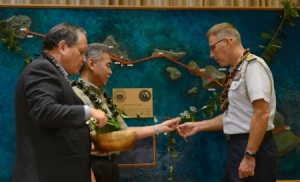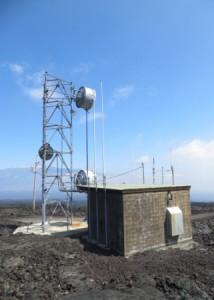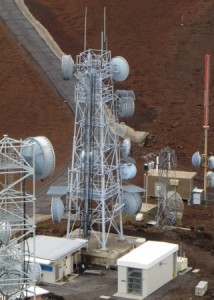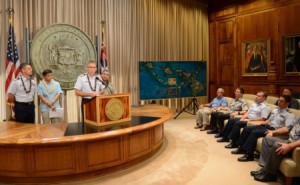State, Coast Guard Complete Safety Network
The State of Hawai’i and United States Coast Guard engineering professionals have completed a “full operating capability” shared infrastructure system to provide robust and survivable communication links and facilities throughout the state.
The ANUENUE Interisland Digital Microwave Network consists of high-capacity microwave links, radio towers, and facility buildings that interconnect and support the systems and networks relied upon by first responders, search and rescue, law enforcement, emergency services, and critical government operations.
In total, twelve ANUENUE “high sites” located on mountain tops connect with eight sites located at state office buildings and USCG properties.
On Thursday, Governor David Ige, State Chief Information Officer Todd Nacapuy, and Captain James Jenkins, USCG District 14 Chief of Staff, gathered in the Executive Chambers to celebrate the completion of the joint project.
“A shared vision and trust between the State of Hawai‘i and the Coast Guard resulted in a partnership that shares resources and capabilities to achieve a common goal of protecting and serving the people of Hawai‘i,” said Governor Ige. “As a result, Hawai‘i is more secure and better prepared for emergencies.”
ANUENUE was designed to survive disasters, natural or otherwise. Its towers and buildings are designed to survive the 155 mph winds of a Category 4 hurricane. Generators are ready to run for a week without commercial power, and earthquake zone 4-rated backbone facilities are located away from tsunami inundation zones.
Backbone towers range in size from 50 to 180 feet tall and support microwave dish antennas as large as 15 feet in diameter. The microwave radio backbone provides a secure 155-Mbit/s SONET connection across the state.
“The ANUENUE Network is a testimony to the superb relationship between the U.S. Coast Guard and the State of Hawai‘i,” Capt. Jenkins said. “This vital system enhances the effectiveness and resiliency of communications among the entire first responder team during both routine operations and for emergent threats such as hurricanes and other natural disasters.”
State officials say that ANUENUE replaced the Rainbow Microwave System, a technologically-outdated predecessor that initiated the concept of shared communications infrastructure and fostered the cooperation and resource sharing critical to the current success.
An initial appropriation by the legislature in 2001 for radio site construction was the beginning of state support of ANUENUE.
The state has invested a total of $19.1 million in ANUENUE facilities and equipment was significantly extended by the USCG contribution to the partnership.
In addition, facilities on the Big Island, Kaua‘i, O‘ahu, Moloka‘i, and Maui were built or refurbished to minimize impacts to sensitive areas and view planes and to be environmentally friendly.
Management of ANUENUE will be jointly managed by the USCG Base Honolulu C4IT Division, which is based on Sand Island, and the state Department of Accounting and General Services’ Information and Communication Services Division (ICSD), which is overseen by the CIO. As part of the ANUENUE agreement, the USCG C4IT Division maintains all of the system’s radios and electronic equipment.
State users of the ANUENUE include the Statewide Shared Blended land mobile radio system; Maritime Wireless Network System; Hawai‘i Emergency Management Agency; and the Departments of Public Safety, Transportation, Health, and Land and Natural Resources. State sponsored users include the County of Maui Police Department and other agencies of all counties.
The Coast Guard’s primary use of the ANUENUE is its new Rescue 21 maritime distress radio system, which has commissioned 10 remote sites in Hawai‘i providing significantly improved coverage and location capabilities over the recently retired National Distress System used to locate mariners in distress. USCG-sponsored federal users include the U.S. Army Pacific Land Mobile Radio System, National Oceanic and Atmospheric Administration Emergency Weather Broadcast System, U.S. Customs and Border Protection, and National Park Service.



















